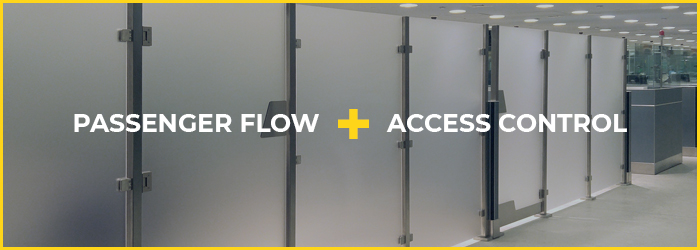
4 Ways Partition Walls Provide Effective Passenger Flow and Access Control
Air travel around the globe is on the rise. The International Air Transport Association is predicting a doubling of annual air travel between 2016 and 2035. With this increase, new airports will be built and existing airports will have to respond to capacity strains on facilities. While facing these strains, airports need solutions that can facilitate a smooth flow of passengers and help facilitate security through access control.
Partition walls are a go-to for airport security, facilities, and operations. You’ll find them throughout the airport in areas such as customs and border patrol, airline gates, hospitality, security, and more.
Here are four ways these architectural solutions can both maintain a smooth flow of passengers throughout the airport and control access where needed to enhance security.
1. They use space efficiently.
In a recent CNBC article, Paul Griffiths, chief executive of Dubai Airports talked about the need for solutions that maximize space utilization. He remarked, "We have tripled our annual passenger through-puts since 2007. So the thing is that as we go forward we've got to find ways of using the current infrastructure more effectively and efficiently.”
Partition walls can serve dual purposes, such as when used with integrated tabletops that create a boundary while doubling as extra space for passenger or agent use. Or with built-in gates to double as passageways.
2. They can easily create permanent or removable boundaries to accommodate passenger flow.
As airports look for ways to modify existing environments, whether as a temporary fix or a permanent update, they need solutions that are easy to implement and easy to maintain. Something as simple as a magnetic base option for stanchions can make installation of free-standing architectural walls easy and effective.
3. They can create secure ingress and egress points for access control.
Access control is a key component of safety and security in airports. It’s not easy. According to a recent AviationPros article, “airports are still working to balance passengers' desire to have a hassle-free experience with the need to guard against all potential threats.” When it comes to instilling control throughout the facility, architectural walls can be a valuable tool. However, a must-have addition for access control is to add locking gates that can be installed where needed within a modular system to allow for secure ingress and egress points.
4. They can avoid unnecessary structural impacts to the airport environment.
With so much in flux, airports are wise to consider solutions that minimize structural impacts to the airport environment. Whether the airport has recently undergone renovation and wishes to maintain the integrity of the new space--or when dealing with an existing environment that demands flexibility and preservation, parition walls can meet the demands. With semi-permanent installation options, partition walls can be removed or reconfigured as needed.
Want to learn more?
Our new airport use case highlights architectural partition walls and gates from Lavi Industries-- a simple yet powerful solution that checks the boxes for passenger flow and access control.
SUBSCRIBE
Subscribe to stay up-to-date with new products, resources information and news.
RECENT RESOURCES
Theft at the Register: How Strategic Queue Design Protects Profits
ViewRapid Deployment Crowd Control: JetTrac Portable Barriers For The Biggest Spaces
View4 Psychological Reasons Your Customers Hate Waiting In Line
ViewFrom Bleachers To Bookstores: 4 Campus Crowd Control Solutions
View








